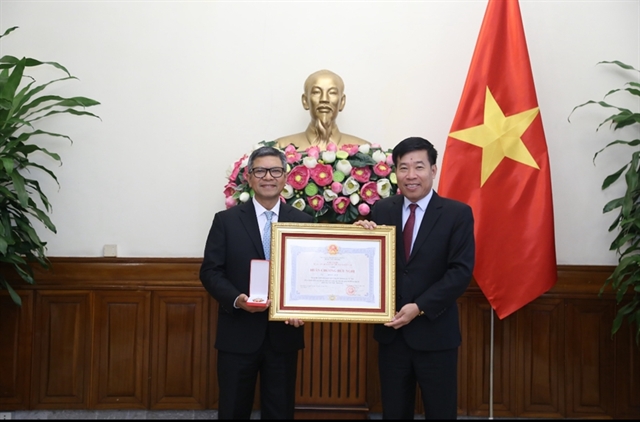 Society
Society


|
| Yên Sở Park in Hoàng Mai District has become popular for camping in recent years. Photo ktdtt.vn |
HÀ NỘI – In recent years, Hà Nội authorities have focused on forming many new residential areas and expanding transport infrastructure to meet the rapid speed of urbanisation and population growth.
However, green and public spaces have lacked adequate investment, according to Kinh Tế & Đô Thị (Economy & City) newspaper.
The city is entering the peak of the stifling summer when people most want fresh air in public spaces and parks but unfortunately, the city has asked people not to gather in public areas due to the new COVID-19 outbreak.
However, on weekends or in the evening areas such as West Lake, Yên Sở Park or Linh Đàm Lake are still packed with people coming to relax, play and exercise, leaving their residential areas.
This situation partly shows that urbanites are increasingly confined to densely built-up areas and face a serious lack of public and green spaces for entertainment and relaxation in their residential areas.
After Hà Nội expanded its administrative boundaries, many new urban areas with hundreds of high-rise buildings were built quickly.
In these modern urban areas, people not only face overcrowding and congestion due to a lack of roads but also suffer from a lack of space for community activities.
Linh Đàm New Residential Area in Hoàng Mai District is one example.
“My family moved to Linh Đàm New Residential Area in 2015. The area has a total of 16 high-rise apartment buildings and 600 villas with more than 10,000 residents but so far there are no community rooms in each building and there is a lack of parks, flower gardens and children's play areas, so all people have to go to Linh Đàm Lake Park to relax and exercise,” said Trần Đức Mậu, a resident in T5 building.
The inner-city area, which is densely populated, is in the same situation. The land used for public green space just accounts for less than 2 per cent of the total land fund.
Meanwhile, some large public parks such as Thủ Lệ in Cầu Giấy District, Thống Nhất and Tuổi Trẻ in Hai Bà Trưng District and Indira Gandhi in Ba Đình District have suffered from a lack of investment, regular maintenance and repairs, so they have gradually deteriorated and become less attractive.
According to architect Đinh Đăng Hải, an expert from Canada’s HealthBridge Foundation in Việt Nam, the area of public space in Hà Nội is very limited at 3sq.m per person.
In Hoàn Kiếm District – one of the central districts of the city - there are only 13 flower gardens and the public area per capita is just 0.1 sq.m, Hải said
“In particular, in the core Old Quarter areas, the public space is even more limited. For example, nearly 70,000 people living in Cửa Đông Ward of Hoàn Kiếm District have only Đường Thành flower garden,” the architect said.
“Hà Nội is still far behind meeting the standards of public space compared to other cities in the world,” he said.
Where there's a will, there's a way
According to Assoc. Prof. Dr Phạm Quỳnh Phương of the Institute for Cultural Studies, Hà Nội’s public spaces have shrunk due to rapid urbanisation. Many new urban areas were formed while land for public purposes was ignored.
In addition, public spaces were being commercialised and privatised. The sidewalk areas were occupied by business households because the distinction between public and private is unclear and many public spaces were used for parking or the expansion of transport infrastructure, Phương said.
City authorities have paid certain attention to public spaces such as expanding green areas, public parks and organising walking streets but these efforts have not met the needs of the people, she said.
“Reclaiming public spaces and operating them well in the city requires community participation because the government can't take care of it all,” the expert said.
“There needs to be a link between urban managers and businesses to create more public spaces for people," she said.
Architect Trần Huy Ánh from the Hà Nội Architects’ Association said that the capital city was in a stage of development in terms of quality, not quantity like before.
“Therefore, there is no reason that we should not pay more attention to the development of public spaces to prove that we are not the richest city but do the most for the people,” Ánh said.
Ánh said that when there was determination, the city would find a way to create enough and satisfactory public spaces.
He said that in the past five years, a district with a narrow area like Hoàn Kiếm has created 13 public spaces, including the walking streets around Hoàn Kiếm Lake, Phùng Hưng art street and public space along the Red River in Phúc Tân Ward.
Notably, under programme No.03-CTr/TU of the Hà Nội Party Committee on urban embellishment and economic development in 2021 - 2025, one of 19 targets identified was to renovate and upgrade 45 existing parks and flower gardens and invest in building five new ones. – VNS


.jpg)

